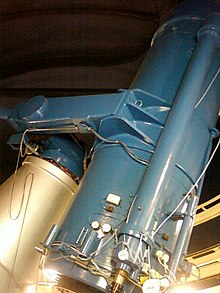Schmidt-Cassegrain telescope
The Schmidt-Cassegrain telescope is a reflector telescope with a concave, spherical main mirror and a scattering secondary mirror, which are located behind a Schmidt corrector plate , forming a Cassegrain arrangement .
In the tube of the Schmidt-Cassegrain telescope, the incident light is bundled by a spherical main mirror ( primary mirror ) and reflected back to the secondary mirror ( secondary mirror ). In contrast to the Newtonian telescope , the light from the secondary mirror is not deflected laterally out of the tube, but reflected back into the center of the main mirror. The main mirror is pierced at this point so that the light is guided out of the tube to the eyepiece . The secondary mirror is attached in the middle of a thin glass pane ( Schmidt plate ) by means of a mirror mount as a separate optical element. The task of this correction plate is to correct the spherical aberration of the main mirror and to minimize the coma of the entire system. The difference to the Maksutov-Cassegrain telescope lies in the correction plate, which in the Maksutov-Cassegrain is very thick and curved ( meniscus lens ).
development

The optician James G. Baker described in 1940 that this arrangement eliminated the field curvature of the Schmidt telescope and reduced its overall length. Like the original Schmidt telescope, this telescope is free from the aberrations of coma and astigmatism and thus also achieves large image angles of several degrees, but it requires at least a slightly aspherical mirror. If, on the other hand, both mirrors are made spherical, a slight astigmatism remains, as Hermann Slevogt pointed out a few years later. A further simplified production and a particularly compact design results if the secondary mirror is also mounted on the corrector plate. In this case, however, the performance of the Schmidt camera is no longer achieved, since image errors remain due to the geometric restriction. However, these can be remedied with a two- or three- lens corrector close to the focus .
Two large, scientifically used instruments and a number of smaller instruments were built according to this principle:
ADH-Baker-Schmidt
In collaboration with the Armagh , Dunsink and Harvard observatories , the ADH-Baker-Schmidt telescope with a 90 cm mirror and a Schmidt corrector with an aperture of 81 cm was built and put into operation in 1950 . The Baker-type C4 telescope has an angle of view of 4.8 °. The telescope was installed in the Boyden Observatory in South Africa until 1981 and was then withdrawn from the Dunsink Observatory, where it was no longer built.
James Gregory Telescope
The largest Schmidt-Cassegrain telescope is the James Gregory Telescope from St. Andrews University with an aperture of 37 inches. The telescope was built in 1962 and has been used scientifically since then, including for the SuperWASP project. It is named after the mathematician James Gregory , who taught in St. Andrews in the 17th century and was also involved in the construction of telescopes, although the Gregory mirror arrangement he developed is not used in this telescope.
Amateur astronomy
The Celestron and Meade companies have been offering a number of smaller telescopes in the Schmidt-Cassegrain mirror arrangement since the late 1960s and early 1980s. These telescopes, which have been optimized with regard to ease of manufacture, have two spherical mirrors, one of which is held by the Schmidt plate. However, this cost-effective structure cannot correct all imaging errors of the first order.
The Meade company also offers a Schmidt-Cassegrain variant with an aperture of 20 cm to 50 cm under the acronym ACF , which stands for Advanced Coma Free , in which the secondary mirror is hyperbolically shaped and the image field is almost flat. Also, the company of Dieter Lichtenknecker presented FLAT FIELD CAMERAS having a similar structure with a diameter between 15 cm and 30 cm ago.
The company ASA Astrosysteme offers a three-lens Schmidt-Cassegrain reducer that is mounted near the focus and reduces aberrations of simple Schmidt-Cassegrain telescopes. In the version called EdgeHD from Celestron, a two- lens corrector is added near the focus, which also eliminates remaining first-order aberrations and reduces others. Telescopes in this design are offered with an aperture of 20 cm to 35 cm.
Web links
swell
- ↑ a b James Gregory Telescope
- ^ J. G. Baker: A family of Flat Field Cameras, Equivalent in Performance to the Schmidt Camera. In: Proceedings, American Philosophical Society. vol. 82, (1940), ISBN 1-4223-7224-3 , p. 339.
- ^ EH Linfoot: The Schmidt-Cassegrain systems and their application to astronomical photography , bibcode : 1944MNRAS.104 ... 48L
- ↑ J. Picht: Slevogt, H .: About a group of aplanatic mirror systems. ( Memento of the original from December 12, 2013 in the Internet Archive ) Info: The archive link was inserted automatically and has not yet been checked. Please check the original and archive link according to the instructions and then remove this notice. In: Z. Instrumentenkunde. 62, 1942, pp. 312-327.
- ↑ Schmidt-Cassegrain Reducer 0.77x ( Memento of the original from November 25, 2013 in the Internet Archive ) Info: The archive link was inserted automatically and has not yet been checked. Please check the original and archive link according to the instructions and then remove this notice. , ASA Astrosystems
- ^ Armagh-Dunsink-Harvard Telescope
- ^ AD Andrews: The Optical Performance of the 81/90 / 3032mm ADH Baker-Schmidt Telescope. bibcode : 1997IrAJ ... 24..116A
- ↑ CJ Butler: THE ARMAGH-DUNSINK-HARVARD TELESCOPE: FROM DREAM TO OBLIVION. (PDF; 1.5 MB)
- ↑ MEADE INSTRUMENTS CORP, MURDOCK STEVEN G: CATADIOPTRIC TELESCOPES. WO2007067701, 2007.
- ↑ ASA Astrosysteme: Schmidt-Cassegrain Reducer 0.77x ( Memento of the original from November 25, 2013 in the Internet Archive ) Info: The archive link was automatically inserted and not yet checked. Please check the original and archive link according to the instructions and then remove this notice. , 2011.

